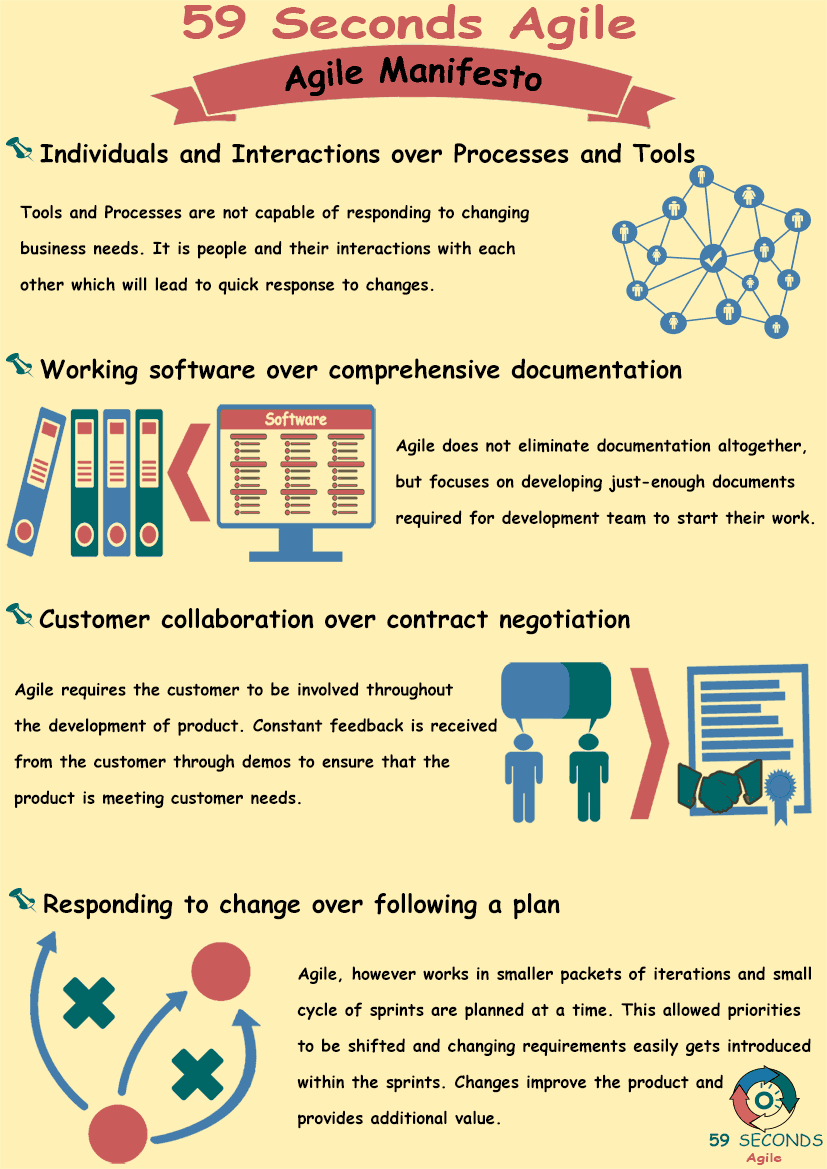Using the Agile Manifesto to Deliver Change
A 59 Seconds Agile Training Video
Continue to Part 12 Below
The Agile Manifesto
A 59 Seconds Agile Article
This article provides an ‘Introduction to the Agile Manifesto’ and looks to discuss what a values are stated within the Manifesto.
Release Planning
Develop an overall plan that takes the backlog list of prioritized features and map each one to delivery sprints. This is not the time to get granular in refining stories. You can use this planning step as an opportunity to split epics, which are large features, into individual user stories.
The release plan is a guideline that will evolve during the life of the project. This is where you will define the desired length of sprints in the project. The general rule of thumb is that no sprint should last longer than 30 days, or be less than one week. Two weeks is the generally accepted length of time for most effective plans.
The release planning activity is a good time to do a high-level evaluation of the anticipated velocity of your core project team to determine which features to include in sprints. Velocity is the total number of points that a team can complete within a sprint. Each user story is assigned story points.
Most scrum teams use the Fibonacci series as a guide for assigning story points. No feature or user story is officially accepted until it is finalised during sprint planning and locked in as a deliverable.
The Agile Manifesto is a declaration of guiding software development principles with the goal of delivering value early in an iterative fashion. The agile manifesto is stated as follows:
“We are uncovering better ways of developing software by doing it and helping others to do it. Through this work, we have come to Value:
Individuals and interactions over processes and tools
Working software over comprehensive documentation
Customer collaboration over contract negotiations
Responding to change over following a plan
That is, while there is Value in the items on the right, we Value the items on the left more.”
©Agile Manifesto Copyright 2001: Kent Beck, Mike Beedle, Arie van Bennekum, Alistair Cockburn, Ward Cunningham, Martin Fowler, James Grenning, Jim Highsmith, Andrew Hunt, Ron Jeffries, Jon Kern, Brian Marick, Robert C. Martin, Steve Mellor, Ken Schwaber, Jeff Sutherland, Dave Thomas. This declaration may be freely copied in any form, but only in its entirety through this notice.
Continue Reading —> Next
The Agile Manifesto
A 59 Seconds Agile Video Animation
Continue Reading —> Next
User Stories Applied
A 59 Seconds Agile Book Review
User Stories Applied by Mike Cohn is one of our favourite books on Agile User Stories. The book starts with an overview into user stories, and details what a user story is and the different aspects of them. He then discusses how to go about writing a user story, and provides details of the INVEST criteria that can be used to determine if the story is meeting all of its objectives. Next Mike gives an in depth discussion of who user stories are written for and where to begin when gathering the details for them. The book then discusses acceptance testing user stories, including how to go about specifying these criteria and the responsibilities of the development team and customers during this process.
Continue Reading —> Next
The Agile Manifesto
A 59 Seconds Agile Infographic

Continue Reading —> Next
Agile Scrum Master Training Course
Our Favourite Agile Books
We found these books great for finding out more information on Agile Scrum:
Continue Reading —> Next


